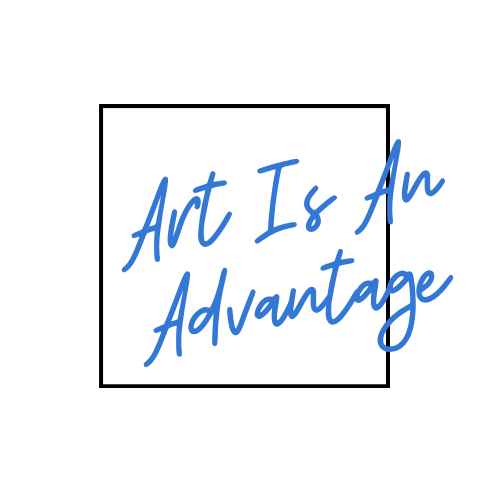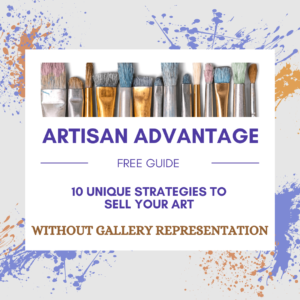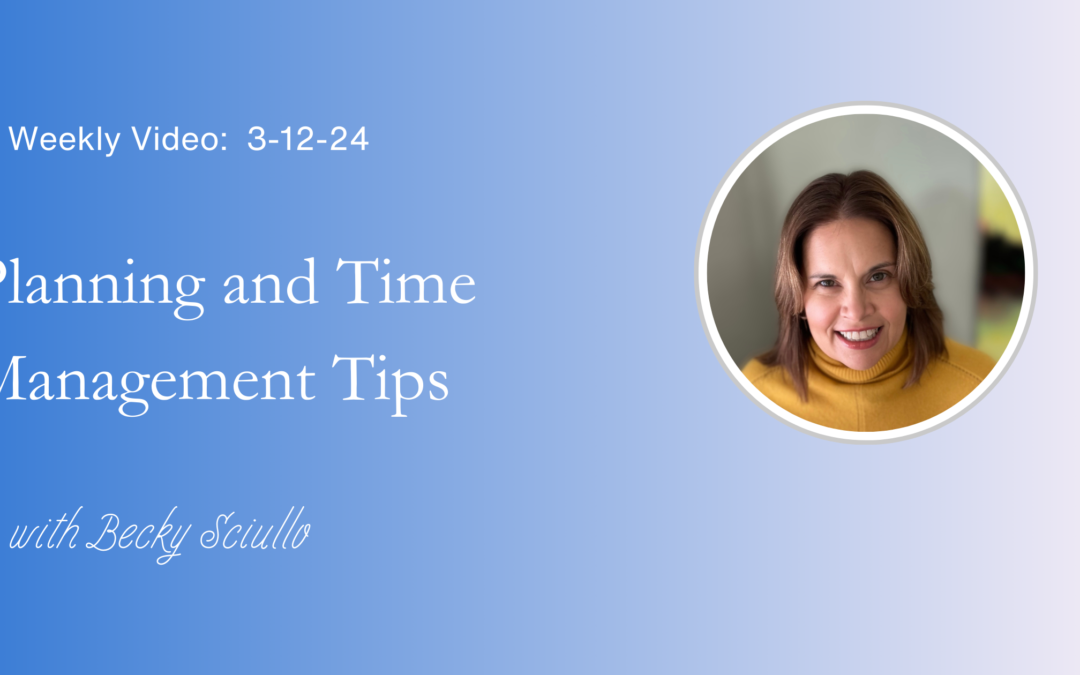
by Rebecca Sciullo | Mar 12, 2024 | Planning, Productivity, Resources, Time Management
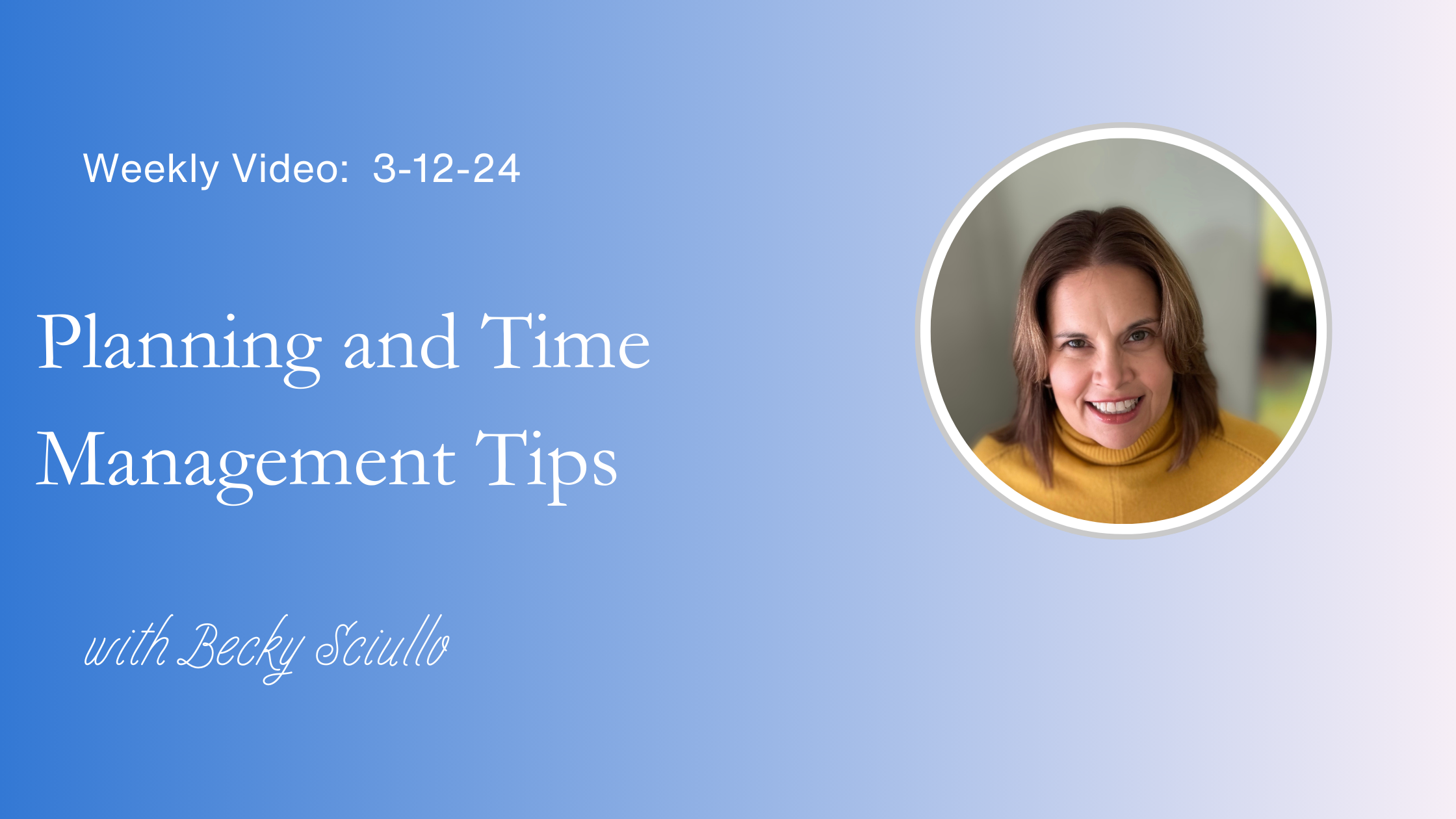
Mastering Time Management and Planning: Your Path to Productivity
This week’s video focuses on some ideas for planning and time management. Recognizing that implementing new marketing strategies sometimes means there is more to do, I share a few ideas around planning and time management that have helped me a lot.

Video Recap
1 – The Rule of 3
I use the number 3 to guide my focus on yearly goals and daily tasks. Choosing three things to strive for or accomplish out of a seemingly never-ending to-do list helps prioritize what needs to be done without getting overwhelmed.
2 – Revisit Your Plans More Than Once a Year
Planning isn’t a once-a-year affair. Establish yearly goals but review them quarterly to adapt to evolving priorities. Break it down further by creating monthly, weekly, and daily plans. This approach encourages flexibility and accomplishment while staying focused on long-term objectives.
3 – Time Blocking
Maximize productivity by scheduling specific tasks and activities on your calendar. Designate dedicated time slots for work projects, studio time, or self-care to stay organized and accountable.
Trust the Process
Remember, progress is about consistent small steps over time. Celebrate each milestone, no matter how small, and trust in the journey toward your goals.
Resources Mentioned in the Video
Create a 12-Month Action Plan: Use the code PLANNING for a 70% discount.
Michael Hyatt’s Full Focus Planner
Join my Weekly Email Newsletter

This post contains affiliate links which means I receive a small commission if you make a purchase using the link. For more information, see my full terms here.
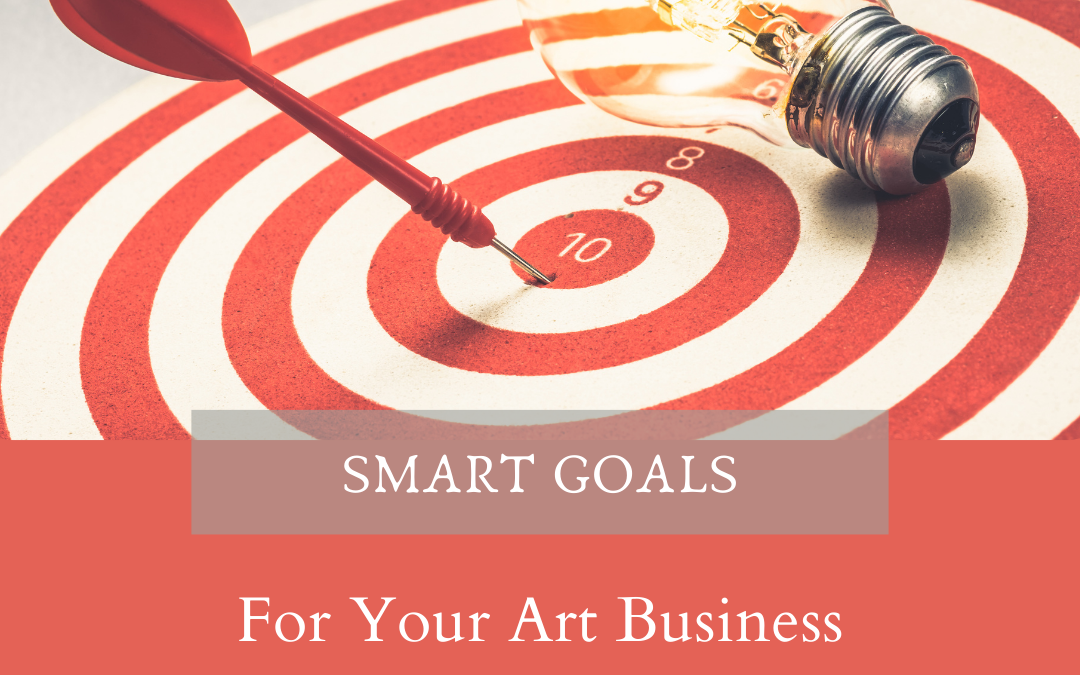
by Rebecca Sciullo | Jan 4, 2024 | Planning
Did you set some goals for your art business for 2024?
Setting goals is crucial to success in any business, including with an art business. In Charting Your Art Business Progress we talked about setting SMART goals. SMART stands for Specific, Measurable, Achievable, Relevant, and Time-based. Applying these principles can significantly enhance the effective use of goal-setting.
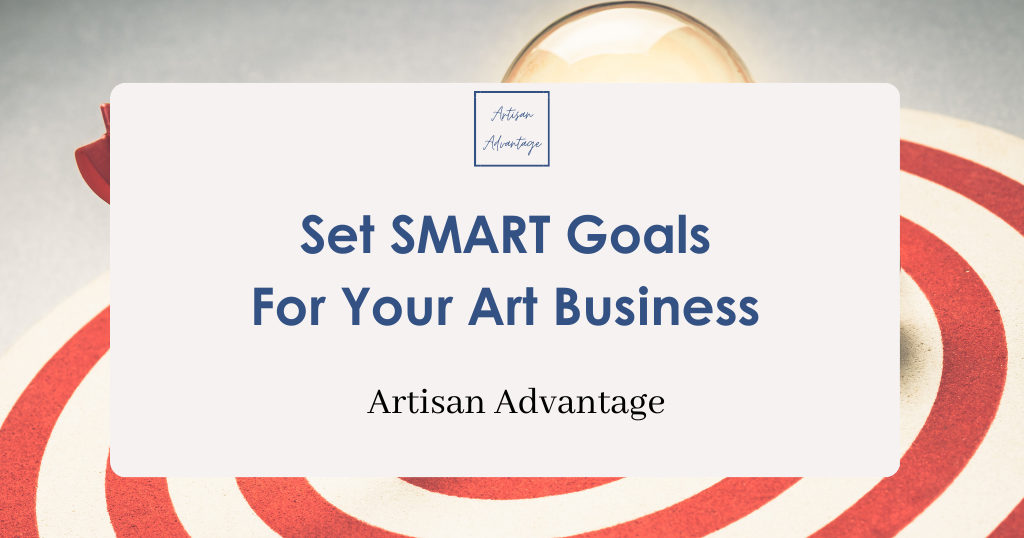
Specific
Instead of a vague aim like “sell more artwork,” a specific goal could be “increase monthly art sales by 25%.”
Measurable
Measurability involves quantifying your objectives, such as tracking the number of artworks sold, the revenue generated, or increased social media engagement.
Achievable
Achievability is vital to prevent setting unrealistic goals that might discourage you in the long run. While aiming high is admirable, set challenging yet feasible goals within your resources and capabilities.
Relevant
Relevance ensures that your goals align with your art business’s vision and mission. They should contribute to its growth and success.
Time
Time-based goals have a set deadline, creating a sense of urgency and accountability. For instance, setting a goal to “launch a new collection in four months” provides a clear timeframe.
Make all of Your Goals for Your Art Business SMART Goals
In an art business, SMART goals could include increasing online presence, expanding into new markets, enhancing customer engagement, or refining artistic skills.
By implementing SMART criteria, you can establish clear objectives, track progress effectively, and move your business toward growth and success.
Get help with your 2024 Planning.
I just released a Guide for creating a 12-month action plan, based on my Charting Your Art Business Program. This Guide consists of a PDF and video recordings and covers SMART goal setting. Learn more about the Guide here.

by Rebecca Sciullo | Dec 28, 2023 | Planning
The Importance of a Vision Statement
In Charting Your Art Business Progress, we discussed the importance of having a long-range vision for your art business. A vision statement serves as the compass that guides your journey within the realm of your art business. Your statement should cover your aspirations, values, and the ultimate destination you want to reach.
While creating a vision statement might seem difficult, it’s importantl to clarify the purpose and direction of your business. Here’s a short guide on writing a compelling vision statement.

A Short Guide to Writing a Vision Statement for Your Art Business
1 – Reflect on Your Values
Consider the values that drive your art and your business. What principles are fundamental to your creative process? Whether it’s innovation, authenticity, social impact, or creative expression, outlining these values should be reflected in your vision.
2 – Define Long Term Goals
Envision where you want your art business to be in the future. Think about the impact you wish to make through your art, desired audience, market presence, or legacy you aim to leave behind. Describe a vivid picture of your ideal scenario.
3 – Be Specific Yet Inspirational
Your vision should be concise yet inspirational. Use clear language to express your aspirations. It should resonate with you, conveying a sense of purpose and passion.
4 – Consider Audience Connection
Reflect on how your art connects with your audience. Acknowledge the emotions, thoughts, or experiences you want to evoke in them through your work. Your vision statement should reflect this connection and the impact on your audience.
5 – Be Authentic
Your vision statement should authentically represent who you are as an artist. It should align with your artistic style, beliefs, and motivations. Authenticity lends credibility and helps establish a genuine connection with your audience.
6 – Be Flexible
While a vision statement serves as a guide, it’s essential to remain adaptable. Things will change over time with your art and the market. So, your vision statement should evolve with your growth and changing aspirations.
7 – Seek Feedback
While your vision statement does not need to be shared publicly, you could share it with a peer, mentor, or trusted friend. Feedback can offer valuable insights and help refine your statement to make it more impactful.
8 – Revise and Refine
Crafting a vision statement is a process. Revise and refine your statement until it feels authentic, inspiring, and aligned with your aspirations.
Your Business Roadmap
Your vision statement serves as a roadmap for your art business. This process guides you for decisions and actions that move you toward your ideal business or career.
For free resources, workshops and other information, join the Artisan Advantage weekly news drop here.
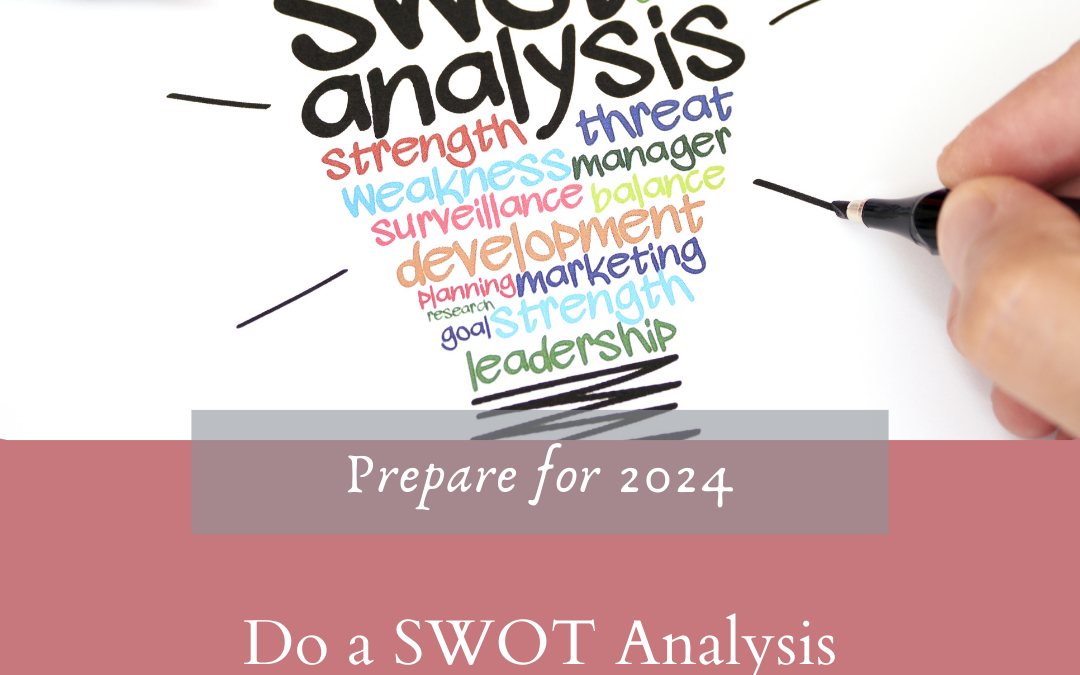
by Rebecca Sciullo | Dec 21, 2023 | Planning
Prepare Your Art Business for 2024
In Charting Your Art Business, we focused on how to plan for 2024. As part of that process, artists were asked to consider a SWOT analysis – a strategic planning method used to evaluate Strengths, Weaknesses, Opportunities, and Threats for their business. Here’s how to do a SWOT analysis to understand where you are currently with your business.
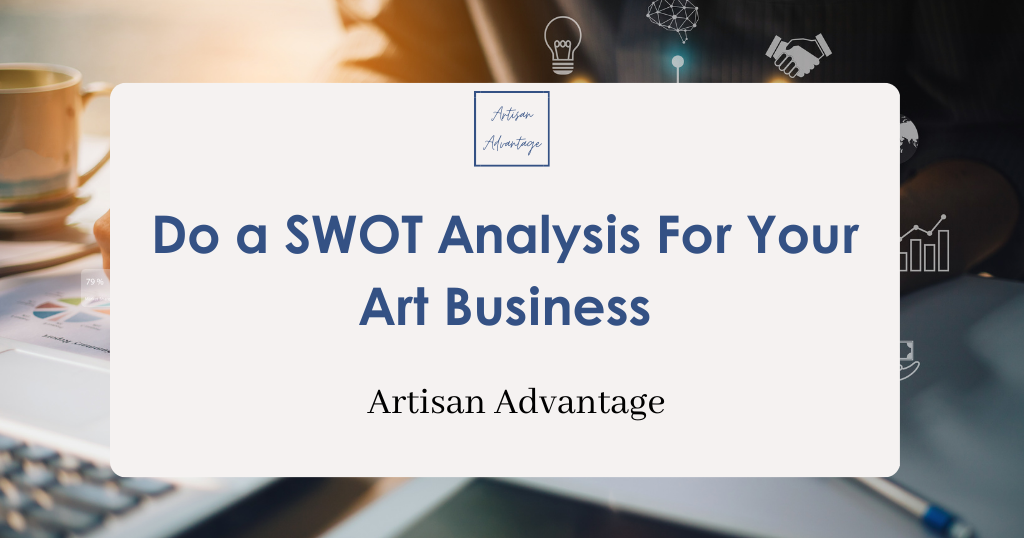
Doing a SWOT Analysis for Your Art Business
Strengths
Begin by identifying the strengths of your art business. What sets your work apart? It could be your unique style, technical skills, a solid social media presence, or a dedicated client base. Consider aspects that give you a competitive edge and contribute to your success. For instance, if you’re skilled in multiple mediums or have a strong network within the art community, these are strengths worth highlighting.
Weaknesses
Next, examine the areas that may hinder your progress. Are there places where you need more expertise or resources? This might involve insufficient marketing strategies, limited exposure, or struggles with time management. Identifying these weaknesses allows you to develop strategies to improve or mitigate them. For instance, if you need help with pricing or managing your online presence, this presents an opportunity for growth.
Opportunities
Explore external factors that could positively impact your art business. These include emerging trends in the art market, potential collaborations, or untapped niche markets. Opportunities could also arise from technological advancements, such as new digital platforms for showcasing or selling artwork. Identifying and leveraging these opportunities can help expand your reach and diversify your artistic endeavors.
Threats
Finally, analyze external threats that could potentially harm your business. This might involve competition from other artists, economic downturns affecting art sales, or shifts in consumer preferences. Awareness of these threats lets you proactively plan strategies to minimize their impact. For example, establishing a diverse income stream or adapting your art to changing market demands can help mitigate threats.
Set Your Framework
Conducting a SWOT analysis provides you with a structured framework to evaluate your art business comprehensively. By recognizing strengths to leverage, addressing weaknesses for improvement, capitalizing on opportunities, and mitigating threats, you can develop informed strategies for sustainable growth. Regularly revisiting and updating this analysis will ensure your art business remains adaptable in a dynamic.
Use the insights from a SWOT analysis to make informed decisions and grow your business.
Would you like help?
If you’d like help with a SWOT or strategizing for your business in 2024, consider letting me help you with an Artist Strategy Intensive.
Questions?
Drop me a line at becky@artisan-advantage.com

by Rebecca Sciullo | Nov 1, 2023 | Planning, Resources
Reviewing the Full Focus Planner by Michael Hyatt
It’s November 1st, so it is time to sit down and make my monthly 40-day plan. One tool that plays a big part in this plan is my Full Focus Planner by Michael Hyatt.
In the saturated world of productivity tools and planners, finding the right one to suit your needs can be overwhelming. I’ve tried everything from online tools to printed material. Over the years, some of the tools I’ve used have come and gone, but the one consistent product that keeps me on track is this planner—a comprehensive, goal-oriented planner designed to help you make the most of your time and achieve your goals.
While I use Google for my online calendar and Notion to keep my projects on track, the Full Focus Planner is my big-picture tool for planning my year, month, weeks, and days.
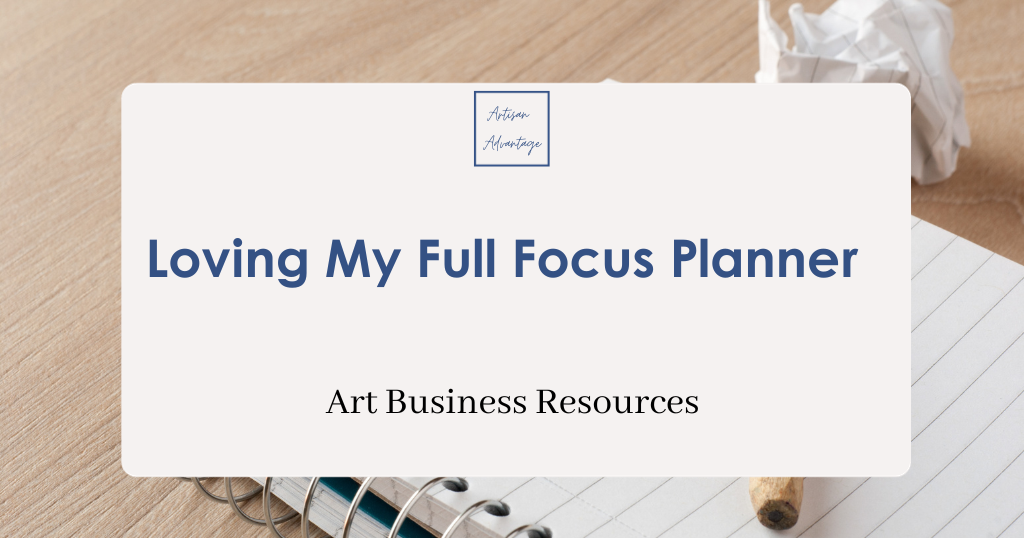
This post contains affiliate links which means I receive a small commission if you make a purchase using the link. For more information, see my full terms here.
Here’s a closer look at what makes this planner stand out.
Goal-Centered Approach
The Full Focus Planner is built around a goal-oriented framework, encouraging me to set clear objectives and break them down into manageable tasks. This focus on goal achievement is a standout feature.
Daily Rituals
The planner uses daily rituals to enhance productivity and mindfulness. Coaxing me into these daily rituals over time has promoted a balanced work-life dynamic. Daily rituals include one in the morning to set priorities and one in the evening for reflection and planning.
Quarterly Goal Setting
With the Full Focus Planner, you set and revisit your goals every quarter. This approach keeps you agile and adaptable, allowing you to adjust over time.
Built-in Time Blocking
Time blocking is seamlessly integrated into the planner, helping you allocate your time effectively and ensuring you stay on track throughout the day.
If you seek a tool to help you set, track, and achieve your goals with intention and accountability, Michael Hyatt’s Full Focus Planner is a great choice.
Get Your Planning Together for 2024 with this Free Program!
Would you like to attend a comprehensive program designed to help you plan your art business for 2024? If so, join me for this two-part program starting on November 14th.

by Rebecca Sciullo | Sep 27, 2023 | Consultations, Planning, Resources
Elevate Your Art Business with an Art Business Review
Are you an artist struggling to navigate the art marketing world? Do you want to reach a wider audience and increase your sales? Consider an Art Business Review with Artisan Advantage
Unlock Your Art Business Potential
In the competitive world of selling art, outstanding work isn’t always enough. It takes strategy, planning, and action to be successful. That’s where an Art Business Review comes in. For a consulting fee of $500, you’ll gain access to one-on-one guidance to design a specific plan for your business.

What You Get with the Art Business Review
This consulting service gives you the assistance you need to design a unique plan to sell your art. Here’s what you can expect when you sign up for the Art Business Review:
1 – Assessment Questionnaire
I start by understanding your current situation, goals, and challenges with a detailed questionnaire.
2 – Onboard/Initial Meeting
We’ll schedule an initial meeting to get to know you and your art business.
3 – Feedback Meeting
You’ll receive honest and constructive feedback on your current strategies and practices.
4 – Written Recommendations
You receive a comprehensive report outlining specific areas for improvement.
5 – Specific Action Steps
I’ll assist you in creating a customized action plan to implement the recommended changes effectively.
6 – Recommended Resources
You’ll receive a curated list of resources to enhance your art business knowledge where needed.
7 – Follow-up/Progress Meeting:
I’ll continue supporting your progress and addressing any questions or concerns in a follow-up meeting after you’ve had time to work with your plan.
8 – 30 Days of Email Support:
Get assistance and clarification for a month after the review via email support.
Schedule a Complimentary Call
Are you ready to take your art business to the next level? Schedule a complimentary call with me to learn more about how an Art Business Review can benefit you. During this call, we’ll discuss your specific needs and how I can tailor my service to help you achieve your goals.
Let me Help!
This comprehensive service will give you experienced guidance, actionable recommendations, and ongoing support to boost your art business’s success.
Take advantage of the opportunity to reach a wider audience and increase your sales. Schedule your complimentary call today and take the first step towards boosting your art business.
Learn more here.

